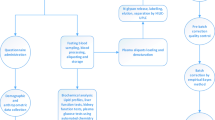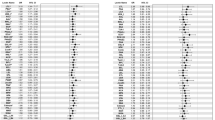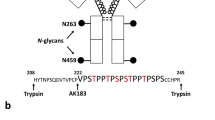Abstract
Hypertension results from the interaction of genetic and acquired factors. IgG occurs in the form of different subclasses, of which the effector functions show significant variation. The detailed differences between the glycosylation profiles of the individual IgG subclasses may be lost in a profiling method for total IgG N-glycosylation. In this study, subclass-specific IgG Fc glycosylation profile was investigated in the four northwestern Chinese minority populations, namely, Uygur (UIG), Kazak (KZK), Kirgiz (KGZ), and Tajik (TJK), composed of 274 hypertensive patients and 356 healthy controls. The results showed that ten directly measured IgG N-glycan traits (i.e., IgG1G0F, IgG2G0F, IgG2G1FN, IgG2G1FS, IgG2G2S, IgG4G0F, IgG4G1FS, IgG4G1S, IgG4G2FS, and IgG4G2N) representing galactosylation and sialylation are significantly associated with hypertension, with IgG4 consistently showing weaker associations of its sialylation, across the four ethnic groups. We observed a modest improvement on the AUC of ROC curve when the IgG Fc N-glycan traits are added into the glycan-based model (difference between AUCs, 0.044, 95% CI: 0.016–0.072, P = 0.002). The AUC of the diagnostic model indicated that the subclass-specific IgG Fc N-glycan profiles provide more information reinforcing current models utilizing age, gender, BMI, and ethnicity, and demonstrate the potential of subclass-specific IgG Fc N-glycosylation profiles to serve as a biomarker for hypertension. Further research is however required to determine the additive value of subclass-specific IgG Fc N-glycosylation on top of biomarkers, which are currently used.
This is a preview of subscription content, access via your institution
Access options
Subscribe to this journal
Receive 12 digital issues and online access to articles
$119.00 per year
only $9.92 per issue
Buy this article
- Purchase on Springer Link
- Instant access to full article PDF
Prices may be subject to local taxes which are calculated during checkout


Similar content being viewed by others
References
World Health Organization. A global brief on hypertension: silent killer, global public health crisis. 2013. http://www.who.int/cardiovascular_diseases/publications/global_brief_hypertension/en/. Accessed 28 Nov 2017.
Lim SS, Vos T, Flaxman AD, Danaei G, Shibuya K, Adair-Rohani H, et al. A comparative risk assessment of burden of disease and injury attributable to 67 risk factors and risk factor clusters in 21 regions, 1990-2010: a systematic analysis for the global burden of disease study 2010. Lancet. 2012;380:2224–60.
World Health Organization. Global status report on noncommunicable diseases 2014. Geneva: World Health Organization; 2014.
Wang Z, Chen Z, Zhang L, Wang X, Hao G, Zhang Z, et al. Status of hypertension in China: results from the China hypertension survey, 2012-2015. Circulation. 2018. https://doi.org/10.1161/CIRCULATIONAHA.117.032380.
Varki A. Biological roles of oligosaccharides: all of the theories are correct. Glycobiology. 1993;3:97–130.
Plomp R, Ruhaak LR, Uh HW, Reiding KR, Selman M, Houwing-Duistermaat JJ, et al. Subclass-specific IgG glycosylation is associated with markers of inflammation and metabolic health. Sci Rep. 2017;7:12325.
Wuhrer M, Stam JC, Fe VDG, Koeleman CA, Verrips CT, Dolhain RJ, et al. Glycosylation profiling of immunoglobulin G (IgG) subclasses from human serum. Proteomics. 2007;7:4070–81.
Pezer M, Stambuk J, Perica M, Razdorov G, Banic I, Vuckovic F, et al. Effects of allergic diseases and age on the composition of serum IgG glycome in children. Sci Rep. 2016;6:33198.
Bakoviä MP, Selman MH, Hoffmann M, Rudan I, Campbell H, Deelder AM, et al. High-throughput IgG Fc N-glycosylation profiling by mass spectrometry of glycopeptides. J Proteome Res. 2013;12:821–31.
Vidarsson G, Dekkers G, Rispens T. IgG subclasses and allotypes: from structure to effector functions. Front Immunol. 2014;5:520.
Keser T, Vuckovic F, Barrios C, Zierer J, Wahl A, Akinkuolie AO, et al. Effects of statins on the immunoglobulin G glycome. Biochim Biophys Acta. 2017;1861(5 Pt A):1152–58.
Zhai F, He Y, Wang Z, Hu Y. Status and characteristic of dietary intake of 12 minority nationalities in China. Wei Sheng Yan Jiu. 2007;36:539–41.
Li J, Lou H, Yang X, Lu D, Li S, Jin L, et al. Genetic architectures of ADME genes in five Eurasian admixed populations and implications for drug safety and efficacy. J Med Genet. 2014;51:614–22.
Gao Q, Dolikun M, J Š, Wang H, Zhao F, Yiliham N, et al. Immunoglobulin G N-Glycans as potential postgenomic biomarkers for hypertension in the Kazakh population. Omics A J Integr Biol. 2017;21:380.
Wang Y, Klarić L, Yu X, Thaqi K, Dong J, Novokmet M, et al. The association between glycosylation of immunoglobulin G and hypertension. Medicine. 2016;95:e3379.
Junren C, Runlin G, Shuiping Z, Guoping L, Dong Z, Jianjun L. Guidelines for the prevention and treatment of dyslipidemia in Chinese adults (revised edition 2016). Chin Circ J. 2016;31:7–28.
Gu D, Reynolds K, Wu X, Chen J, Duan X, Muntner P, et al. Prevalence, awareness, treatment, and control of hypertension in china. Hypertension. 2002;40:920–7.
Selman MH, Derks RJ, Bondt A, Palmblad M, Schoenmaker B, Koeleman CA, et al. Fc specific IgG glycosylation profiling by robust nano-reverse phase HPLC-MS using a sheath-flow ESI sprayer interface. J Proteomics. 2012;75:1318–29.
Gornik O, Pavic T, Lauc G. Alternative glycosylation modulates function of IgG and other proteins—implications on evolution and disease. Biochim Biophys Acta. 2012;1820:1318–26.
Benjamini Y, Hochberg Y. Controlling the false discovery rate—a practical and powerful approach to multiple testing. J R Stat Soc. 1995;57:289–300.
Plomp R, Bondt A, de Haan N, Rombouts Y, Wuhrer M. Recent advances in clinical glycoproteomics of immunoglobulins (Igs). Mol Cell Proteomics. 2016;15:2217–28.
Lu JP, Knežević A, Wang YX, Rudan I, Campbell H, Zou ZK, et al. Screening novel biomarkers for metabolic syndrome by profiling human plasma N-glycans in Chinese Han and Croatian populations. J Proteome Res. 2011;10:4959–69.
Krištić J, Zoldoš V, Lauc G. Complex genetics of protein N-glycosylation. In: Endo T, Seeberger PH, Hart GW, Wong C-H, Taniguchi N, editors. Glycoscience: biology and medicine. Japan: Blackwell Publishing Ltd.; 2014, p. 1–7.
Voight BF, Scott LJ, Steinthorsdottir V, Morris AP, Dina C, Welch RP, et al. Twelve type 2 diabetes susceptibility loci identified through large-scale association analysis. Nat Genet. 2010;42:579–89.
Zhao F, Mamatyusupu D, Wang Y, Fang H, Wang H, Gao Q, et al. The Uyghur population and genetic susceptibility to type 2 diabetes: potential role for variants in CAPN10,APM1 and FUT6 genes. J Cell Mol Med. 2016;20:2138–47.
Russell AC, Simurina M, Garcia MT, Novokmet M, Wang Y, Rudan I, et al. The N-glycosylation of immunoglobulin G as a novel biomarker of Parkinson's disease. Glycobiology. 2017;27:501–10.
Parekh R, Isenberg D, Rook G, Roitt I, Dwek R, Rademacher T. A comparative analysis of disease-associated changes in the galactosylation of serum IgG. J Autoimmun. 1989;2:101–14.
Parekh RB, Dwek RA, Sutton BJ, Fernandes DL, Leung A, Stanworth D, et al. Association of rheumatoid arthritis and primary osteoarthritis with changes in the glycosylation pattern of total serum IgG. Nature. 1985;316:452–7.
Bond A, Alavi A, Axford JS, Bourke BE, Bruckner FE, Kerr MA, et al. A detailed lectin analysis of IgG glycosylation, demonstrating disease specific changes in terminal galactose and N-acetylglucosamine. J Autoimmun. 1997;10:77–85.
Mihai S, Nimmerjahn F. The role of Fc receptors and complement in autoimmunity. Autoimmun Rev. 2013;12:657–60.
Karsten CM, Pandey MK, Figge J, Kilchenstein R, Taylor PR, Rosas M, et al. Anti-inflammatory activity of IgG1 mediated by Fc galactosylation and association of FcγRIIB and dectin-1. Nat Med. 2012;18:1401–06.
Dall'Olio F, Vanhooren V, Chen CC, Slagboom PE, Wuhrer M, Franceschi C. N-glycomic biomarkers of biological aging and longevity: a link with inflammaging. Ageing Res Rev. 2013;12:685–98.
Kaneko Y, Nimmerjahn F, Ravetch JV. Anti-inflammatory activity of immunoglobulin G resulting from Fc sialylation. Science. 2006;313:670–3.
Chae CU, Lee RT, Rifai N, Ridker PM. Blood pressure and inflammation in apparently healthy men. Hypertension. 2001;38:399–403.
Marvar PJ, Thabet SR, Guzik TJ, Lob HE, McCann LA, Weyand C, et al. Central and peripheral mechanisms of T-lymphocyte activation and vascular inflammation produced by angiotensin II-induced hypertension. Circ Res. 2010;107:263–70.
Solak Y, Afsar B, Vaziri ND, Aslan G, Yalcin CE, Covic A, et al. Hypertension as an autoimmune and inflammatory disease. Hypertens Res. 2016;39:567–73.
Acknowledgements
This study was supported by the National Natural Science Foundation of China (81573215, 31460285, and 81370083), Australian National Health and Medical Research Council (NH&MRC-APP1046711). Genos has received funding from European Commission FP7 grants MIMOmics (contract #305280), HTP-GlycoMet (contract #324400) and PainOmics (contract #602736), and H2020 grants GlySign (contract #722095), GlyCoCan (contract #676412), SYSCID (contract #733100), and IMforFuture (contract #721815) as well as funding from the European Structural and Investments funds for projects “New generation of high througput glycoanalytical services (contract #KK.01.2.1.01.0003) and “Croatian National Centre of Research Excellence in Personalized Healthcare” (contract #KK.01.1.1.01.0010). HW was supported by China Scholarship Council (CSC No. 201708110200). The authors thank the directors and relevant staff of relevant Health Bureaus for their support for recruiting the Uygur, Kazak, Kirgiz, and Tajik participants, and these volunteers and community leaders for their participation and support.
Author information
Authors and Affiliations
Corresponding authors
Ethics declarations
Conflict of interest
G. Lauc is the founder and owner of Genos Ltd, a private research organization that specializes in high-throughput glycomic analysis and has several patents in this field. J. Štambuk, I. Trbojević-Akmačić, A. Momčilović and G. Razdorov are employees of Genos Ltd.
Electronic supplementary material
41371_2018_71_MOESM2_ESM.xlsx
Directly measured subclass-specific IgG Fc N-glycome composition in hypertension patients and healthy controls for the four separate ethnic groups, and a pooled group of all four ethnic groups
41371_2018_71_MOESM3_ESM.xlsx
Derived subclass-specific IgG Fc N-glycome composition in hypertension patients and healthy controls for the four separate ethnic groups, and a pooled groups of all four ethnic groups
Rights and permissions
About this article
Cite this article
Liu, J., Dolikun, M., Štambuk, J. et al. The association between subclass-specific IgG Fc N-glycosylation profiles and hypertension in the Uygur, Kazak, Kirgiz, and Tajik populations. J Hum Hypertens 32, 555–563 (2018). https://doi.org/10.1038/s41371-018-0071-0
Received:
Revised:
Accepted:
Published:
Issue Date:
DOI: https://doi.org/10.1038/s41371-018-0071-0
This article is cited by
-
Unravelling the genetic causality of immunoglobulin G N-glycans in ischemic stroke
Glycoconjugate Journal (2023)
-
Association of dementia with immunoglobulin G N-glycans in a Chinese Han Population
npj Aging and Mechanisms of Disease (2021)
-
Extensive weight loss reduces glycan age by altering IgG N-glycosylation
International Journal of Obesity (2021)
-
Prevalence of high blood pressure and high normal blood pressure among 7- to 17-year-old children and adolescents in developed regions, China from 2014 to 2017: using new national blood pressure reference for Chinese children and adolescents
Journal of Human Hypertension (2019)



